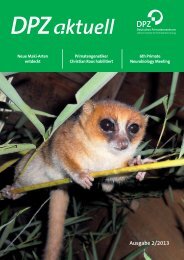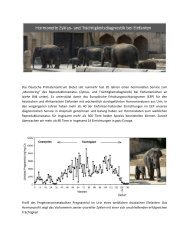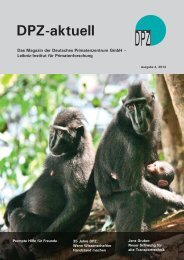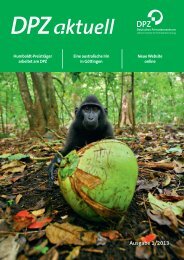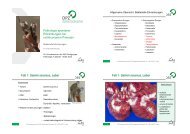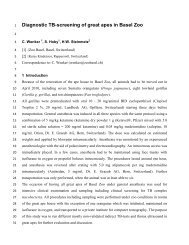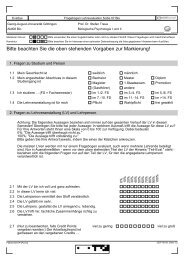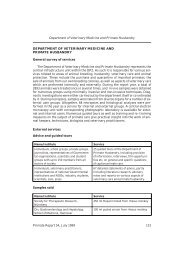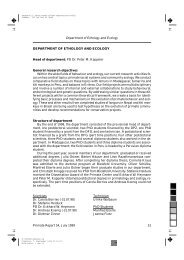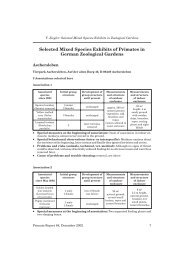Vol. 15 - Deutsches Primatenzentrum
Vol. 15 - Deutsches Primatenzentrum
Vol. 15 - Deutsches Primatenzentrum
Create successful ePaper yourself
Turn your PDF publications into a flip-book with our unique Google optimized e-Paper software.
Lemur News <strong>Vol</strong>. <strong>15</strong>, 2010 Page 61<br />
1996; Luikart et al., 1998; Piry et al., 1999) under the Infinite<br />
Alleles Model (IAM; Kimura and Crow, 1964), the Stepwise<br />
Mutation Model (SMM;Ohta and Kimura,1973),and the Two<br />
Phase Model (TPM;di Rienzo et al.,1995).We varied the proportion<br />
of the single step contribution to the TPM to identify<br />
the P < 0.05 threshold of significance.The program identifies<br />
populations with an excess of heterozygosity relative to<br />
mutation-drift equilibrium which is indicative of a reduction<br />
in the effective population size (Maruyama and Fuerst,1985).<br />
An estimate of relationships among all individuals sampled at<br />
each forest was done in SPAGeDi (Hardy and Vekemans,<br />
2002),then compared to a simulation of known pedigreed individuals.<br />
The analysis was performed to calculate the relationship<br />
coefficients described in Queller and Goodnight<br />
(1989) in the absence of spatial data.<br />
Results<br />
Genetic diversity as mean number of alleles ranged from<br />
6.08-8.92 per population. Using the rarefacted allelic richness,<br />
the range lowered to 5.87-7.67. The expected heterozygosity<br />
ranged from 0.77-0.86 (P > 0.05;Fig.2) with an average<br />
of 0.81, while the observed heterozygosity ranged from<br />
0.65-0.84 (P < 0.05; Fig. 3) with an average of 0.74. The number<br />
of effective breeders in the sampled populations averaged<br />
between 12.6 and 39.6 per population (Tab. 2).<br />
Results from Bottleneck showed that none of the 10 populations<br />
deviated from a mutation-drift equilibrium under the<br />
SMM.Three populations,Anjanaharibe Sud,Ambatovaky and<br />
Anjozorobe did not show evidence of population bottleneck<br />
under the IAM either.The rest of the populations were significant<br />
for bottleneck events under the IAM and varying proportions<br />
of single step contributions under the TPM.<br />
The frequencies of the relationship coefficients estimated<br />
using SPAGeDi were overlaid upon a simulation generated<br />
from known pedigreed data so that each of the population’s<br />
relative distribution of relationships could be compared with<br />
parent offspring, full sibling, half sibling and unrelated relationship<br />
coefficient distributions (Fig. 4). The data indicated<br />
that the sampling was from individuals that were somewhat<br />
related more than the unrelated individuals in the reference<br />
simulation. Inbreeding can also be due to background relatedness<br />
where an increased allelic identity by descent is a result<br />
from bottleneck events in the population’s history.Relationship<br />
coefficient distributions sup-<br />
port the assumption that the individuals<br />
sampled were often from family<br />
groups. All of these sources may potentially<br />
be due to the effects of habitat<br />
fragmentation which is certainly<br />
the case in the Anosibe an’ala population<br />
where the habitat is so fragmented<br />
that although multiple family<br />
groups were encountered, they were<br />
found in isolated forest fragments.<br />
Discussion<br />
Of the 10 Indri populations sampled,<br />
six (Anjanaharibe Sud, Ambatovaky,<br />
Zahamena, Betampona, Mantadia, and<br />
Anosibe an’ala) deviated from HWE<br />
with an excess of homozygotes.Considering<br />
inbreeding as potential cause,<br />
five of the populations (Anjanaharibe<br />
Sud, Ambatovaky, Betampona, Mantadia,<br />
and Andasibe) had relatively<br />
high FIS and one (Anosibe an’ala) had<br />
Y<br />
.90<br />
.80<br />
.70<br />
.60<br />
55DD<br />
A B C D E F G H I J<br />
X<br />
Fig. 2: Ranges of expected heterozygosities with 95 % confidence<br />
intervals: A) Anjanaharibe Sud; B) Marotandrano; C)<br />
Ambatovaky; D) Zahamena; E) Betampona; F) Anjozorobe;<br />
G) Mantadia;H) Andasibe;I) Maromizaha; J) Anosibe an’ala.<br />
4DF4<br />
Y<br />
.90<br />
.85<br />
.80<br />
.75<br />
A B C D E F G H I J<br />
X<br />
Fig. 3: Ranges of observed heterozygosities with 95 % confidence<br />
intervals: A) Anjanaharibe Sud; B) Marotandrano; C)<br />
Ambatovaky; D) Zahamena; E) Betampona; F) Anjozorobe;<br />
G) Mantadia;H) Andasibe;I) Maromizaha; J) Anosibe an’ala.<br />
Tab. 2: Population genetic parameter estimates for 10 populations comprised of n<br />
samples each derived from 12 microsatellite loci for number of alleles (k), the mean<br />
number of alleles (MNA), allelic richness (AR), probability of satisfying Hardy-Weinberg<br />
Equilibrium (HWE), observed (HO) and expected (HE) heterozygosities, inbreeding<br />
estimate (FIS), the number of effective breeders (Neb) estimated with the<br />
linkage disequilibrium method and 95 % confidence interval,and results from the Bottleneck<br />
test under the infinite allele model (IAM) and the two phased model (TPM)<br />
with proportion of multistep mutations contributing to the P < 0.05 significance level.<br />
n k MNA AR HWE HO HE FIS Neb 95% CI IAM TPM<br />
ANJ 10 80 6.67 6.41 * 0.67 0.77 0.135 23.0 16.2-37.8 NS NS<br />
TAND 10 73 6.08 5.87 NS 0.75 0.77 0.024 21.9 <strong>15</strong>.1-36.9 ** 70<br />
VAK 11 76 6.33 5.92 NS 0.69 0.77 0.121 20.1 14.7-30.4 NS NS<br />
ZAH 14 107 8.92 7.65 NS 0.81 0.86 0.060 39.6 28.8-61.3 ** 10<br />
BET 10 79 6.58 6.37 ** 0.73 0.80 0.093 18.3 13.5-27.1 ** 20<br />
ANJZ 10 83 6.92 6.70 NS 0.84 0.79 -0.066 20.9 <strong>15</strong>.1-32.5 NS NS<br />
TAD 10 96 8.00 7.67 NS 0.75 0.85 0.120 20.1 <strong>15</strong>.3-28.3 ** 70<br />
DASI 11 81 6.75 6.40 NS 0.73 0.81 0.095 12.6 10.2-16.2 ** 5<br />
MIZA 10 89 7.42 7.17 NS 0.83 0.84 0.021 <strong>15</strong>.9 12.4-21.3 ** 5<br />
ANOSIBE 10 92 7.67 7.38 * 0.65 0.85 *0.236 28.8 19.9-49.3 ** NS<br />
* P < 0.05, ** P < 0.001; Anjanaharibe-Sud(ANJ), Marotandrano (TAND), Ambatovaky (VAK),<br />
Zahamena (ZAH), Betampona (BET), Anjozorobe (ANJZ), Mantadia (TAD), Andasibe (DASI).<br />
Maromizaha (MIZA), Anosibe an’ala (ANOSIBE).





